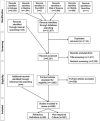Summarizing current refractory disease definitions in rheumatoid arthritis and polyarticular juvenile idiopathic arthritis: systematic review
- PMID: 33710321
- PMCID: PMC8328502
- DOI: 10.1093/rheumatology/keab237
Summarizing current refractory disease definitions in rheumatoid arthritis and polyarticular juvenile idiopathic arthritis: systematic review
Abstract
Objectives: To identify how refractory disease (or relevant terminology variations) in RA and polyarticular JIA (polyJIA) is defined and establish the key components of such definitions.
Methods: Searches were undertaken of English-language articles within six medical databases, including manual searching, from January 1998 to March 2020 (PROSPERO: CRD42019127142). Articles were included if they incorporated a definition of refractory disease, or non-response, in RA/polyJIA, with clear components to the description. Qualitative content analysis was undertaken to describe refractory disease in RA/polyJIA and classify each component within each definition.
Results: Of 6251 studies screened, 646 met the inclusion criteria; 581 of these applied non-response criteria while 65 provided refractory disease definitions/descriptions. From the non-response studies, 39 different components included various disease activity measures, emphasizing persistent disease activity and symptoms, despite treatment with one or more biologic DMARD (bDMARD). From papers with clear definitions for refractory disease, 41 components were identified and categorized into three key themes: resistance to multiple drugs with different mechanisms of action, typically two or more bDMARDs; persistence of symptoms and disease activity; and other contributing factors. The most common term used was 'refractory' (80%), while only 16.9% reported explicitly how their definition was generated (e.g. clinical experience or statistical methods).
Conclusion: Refractory disease is defined as resistance to multiple drugs with different mechanisms of action by persistence of physical symptoms and high disease activity, including contributing factors. A clear unifying definition needs implementing, as the plethora of different definitions makes study comparisons and appropriate identification of patients difficult.
Keywords: definitions; juvenile idiopathic arthritis; non-response; refractory disease; rheumatoid arthritis; treatment-resistant.
© The Author(s) 2021. Published by Oxford University Press on behalf of the British Society for Rheumatology.
Figures




References
-
- Stevenson M, Archer R, Tosh J. et al. Adalimumab, etanercept, infliximab, certolizumab pegol, golimumab, tocilizumab and abatacept for the treatment of rheumatoid arthritis not previously treated with disease-modifying antirheumatic drugs and after the failure of conventional disease-modifying antirheumatic drugs only: systematic review and economic evaluation. Health Technol Assess 2016;20:1–610. - PMC - PubMed
-
- Druce KL, Bhattacharya Y, Jones GT, Macfarlane GJ, Basu N.. Most patients who reach disease remission following anti-TNF therapy continue to report fatigue: results from the British Society for Rheumatology Biologics Register for Rheumatoid Arthritis. Rheumatology 2016;55:1786–90. - PubMed
Publication types
MeSH terms
LinkOut - more resources
Full Text Sources
Other Literature Sources
Medical
Miscellaneous

